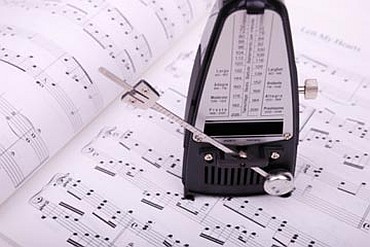The first metronomes were spring wound and, like old watches, they tended to keep time poorly as the springs lost tension. Today’s metronomes are more reliable. Some can even be programmed to play a variety of sounds, from conga drums to electronic cheeps and beyond. Head over to the next page to read all about how different kinds of metronomes work.
The Wide World of Metronomes
Most people think of a metronome as a blocky, pyramid-shaped contraption with a pendulum. Though these mechanical metronomes are still in use, the term metronome can also refer to any instrument used to keep tempo. Here are few different types of musical timekeeping devices:
- Mechanical metronomes are similar in appearance to the original Maelzel’s Metronome. Though they may be made out of materials other than wood, they retain the pyramid shape and swinging-pendulum tick of the original.
- Quartz metronomes are an inexpensive alternative to the mechanical metronome. Usually made of plastic, these timekeepers have an adjustable beats-per-minute (BPM) dial. Some offer a light that flashes along with the beat so that users have a visual as well as an auditory tempo cue.
- Digital metronomes are a step up from quartz metronomes. Varieties like the BOSS Dr. Beat offer a variety of time signatures and the option to hear a tone on the eighth and 16th notes as well as the quarter note. You can also tap in the tempo, which can be very useful. Some models even offer a range of tempo tones, from electronic beeps to more natural drum or clave sounds.
- Software metronomes are virtual metronomes you can use online or download onto a computer or handheld device. Many of these are available as freeware or shareware.
- Click tracks are used for professional recording. Virtually all digital recording software, from Garageband to ProTools, includes a click track, which can be enabled or disabled at will. If you’re recording to analog tape, you can create a click track by recording the sound of any metronome and then using this “click” track to keep a steady tempo as you layer other instruments.
- A backing track is a piece of music (as opposed to a simple tick-tock or click) that has been prerecorded using a metronome or click track. For instance, a guitarist might play a song’s basic rhythm to a click track, and then the band might record their parts while listening to his or her prerecorded guitar.
From Beethoven to beatbox, just about every genre of music has used and benefited from the structure of a metronome. Still, some musicians wonder if using a metronome will make their playing sound mechanical or robotic. We address that concern after the jump.
For more Detail: How Metronomes Work

